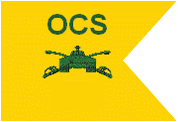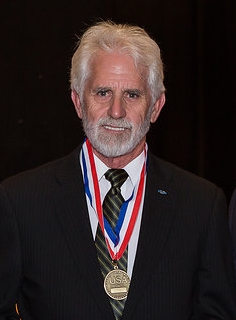|
|

Graduates Awarded the Distinguished Service
Cross
Last Updated on: Monday, February 10, 2020
08:08:02 AM
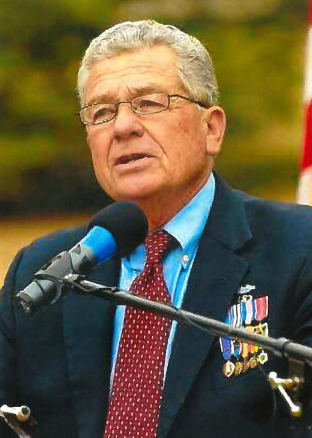
1LT
Lee B.
Alley
Headquarters
and
Headquarters Company, 5th Battalion (Mechanized), 60th Infantry,
9th Infantry Division |
First Lieutenant
Lee
B. Alley, Class 18-66 Company C1
Citation:
The
President of the United States of America, authorized by Act of
Congress, July 9, 1918 (amended by act of July 25, 1963), takes
pleasure in presenting the Distinguished Service Cross to First
Lieutenant (Armor) Lee B. Alley (ASN: 0-5233466), United States
Army, for extraordinary heroism in connection with military
operations involving conflict with an armed hostile force in the
Republic of Vietnam while serving with Headquarters and
Headquarters Company, 5th Battalion (Mechanized), 60th Infantry,
9th Infantry Division. First Lieutenant Alley distinguished himself
by exceptionally valorous actions on 18 November 1967 as leader of
a platoon providing security for a fire support base in Ding Tuong
Province. In the early morning hours, a Viet Cong battalion
directed a coordinated mortar and ground attack on the platoon's
perimeter. The numerically superior enemy soon closed on the unit's
position, and Lieutenant alley decided to withdraw to a more
defensible location near the artillery camp which was across a
river. Braving savage fire, he exposed himself to the enemy weapons
and directed his men to the stream, personally pulling a wounded
comrade to the bank. Completely disregarding his safety, he then
returned to his original position and poured murderous fire into
the advancing enemy ranks to cover the movement of his troops.
Heedless of a painful wound, he fought furiously until he ran out
of ammunition. After obtaining another weapon and grenades, he
continued his valiant fight until his men reached safety. He then
maneuvered to join them and, after crossing the river, he sighted
four soldiers remaining on the opposite side who were pinned down
by heavy fire. Lieutenant Alley returned through a curtain of
bullets to reach them and lead them back across the river to the
new perimeter. He then directed ravaging air, artillery and gunship
strikes on the insurgents which forced them to flee the battlefield
in disorder. First Lieutenant Alley's extraordinary heroism and
devotion to duty were in keeping with the highest traditions of the
military service and reflect great credit upon himself, his unit,
and the United States Army. |
|
|
Posthumous
Award

CPT
Norman
Earl Baldwin
Detachment
B-20, Company B, 5th Special Forces Group (Airborne), 1st Special
Forces
|
Captain Norman Earl
Baldwin, Class 18-66 Company C1
Citation:
The
President of the United States takes pride in presenting the
Distinguished Service Cross (Posthumously) to Norman Earl Baldwin
(0-5233469), Captain (Armor), U.S. Army, for extraordinary heroism
in connection with military operations involving conflict with an
armed hostile force in the Republic of Vietnam, while serving with
Detachment B-20, Company B, 5th Special Forces Group (Airborne),
1st Special Forces. Captain Baldwin distinguished himself by
exceptionally valorous actions on 25 August 1968 as the commander
of a mobile strike force company engaged in relieving the besieged
Duc Lap Special Forces camp. During as assault on a hill occupied
by an estimated North Vietnamese Army company, he found himself
alone and under intense enemy small arms and automatic weapons
fire. Shouting encouragement to his men to follow him, he rushed
forward and single-handedly wiped out an enemy bunker, killing
three aggressors. Seeing this heroic act on the part of their
commander, his troops began to advance. Twenty feet from the crest
of the hill Captain Baldwin and his company came under a withering
barrage of small arms and automatic weapons fire from hostile
positions southwest of their line of assault. Captain Baldwin
placed a burst of fire on the enemy emplacements from an exposed
position, inspiring his men to also locate and bring fire against
them. He continued to lead the assault in the face of a hail of
bullets, and when he had nearly reached the top of the hill he was
mortally wounded by the North Vietnamese fusillade. Captain
Baldwin's extraordinary heroism and devotion to duty, at the cost
of his life, were in keeping with the highest traditions of the
military service and reflect great credit upon himself, his unit,
and the United States Army.
|
|
|
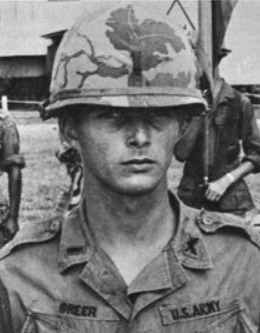
1LT
Earl D.
Greer
Headquarters and Headquarters Company, 2d Battalion, 34th Armor,
25th Infantry Division
|
First Lieutenant
Earl
D. Greer, Class 2-67 Company B1
Citation:
The
President of the United States takes pleasure in presenting the
Distinguished Service Cross to Earl D. Greer (0-5241025), First
Lieutenant (Armor), U.S. Army, for extraordinary heroism in
connection with military operations involving conflict with an
armed hostile force in the Republic of Vietnam, while serving with
Headquarters and Headquarters Company, 2d Battalion, 34th Armor,
25th Infantry Division. First Lieutenant Greer distinguished
himself by exceptionally valorous actions during the period 26 to
29 February 1968 as a platoon leader of a task force on a mission
near Tan Hoa. On 26 February, Lieutenant Greer's personnel carrier
was struck during an enemy attack by an anti-tank rocket and he was
painfully wounded. He refused medical evacuation, quickly assessed
the situation and directed fire into the insurgents' positions.
When one of his platoon's vehicle commanders was severely wounded
by the hostile fire, he dismounted his vehicle and, disregarding
his safety, ran through a withering hail of enemy bullets to render
aid to the man and move him to a place of safety. The following
morning, Lieutenant Greer spearheaded the task force's attack by
destroying several bunker complexes. During the continuous fighting
that followed near the village of Ap Ban Tram, one of his personnel
carriers was struck by a rocket which seriously wounded the
vehicle's driver. Lieutenant Greer immediately returned the fire,
killing the enemy gunner. While under intense fire from several
other concealed positions, he dismounted his vehicle and attached a
tow cable to the disabled armored personnel carrier to extract it
from the battle area. After the vehicle had been removed, he led
his platoon in an assault on the enemy, killing three and capturing
four North Vietnamese soldiers. Later, infantry elements east of
the village were pinned down by intense hostile automatic weapons
fire. He maneuvered his vehicle into position and directed
counterfire on the entrenched insurgents positions which allowed
the beleaguered units to disengage the enemy. The movement exposed
his armored personnel carrier to the insurgents and it was struck
by anti-tank fire which resulted in the entire crew being wounded.
With his carrier in flames and painfully wounded himself,
Lieutenant Greer personally extracted the other crew members before
allowing himself to be given medical treatment. Throughout the
entire four days of fighting, his personal acts of courage were a
constant source of inspiration to his troops. First Lieutenant
Greer's extraordinary heroism and devotion to duty were in keeping
with the highest traditions of the military service and reflect
great credit upon himself, his unit, and the United States
Army.
|
|
|
Fiddler's Green
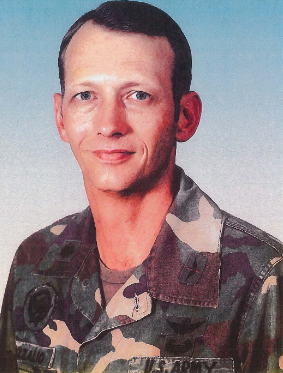
1LT
Alan
Ace Cozzalio
Company
D,
3d Squadron, 5th Cavalry, 9th Infantry Division
|
Captain Alan Ace
Cozzalio, Class 4-67 Company E2
Citation:
The
President of the United States takes pleasure in presenting the
Distinguished Service Cross to Alan A. Cozzalio (0-5241198), First
Lieutenant (Armor), U.S. Army, for extraordinary heroism in
connection with military operations involving conflict with an
armed hostile force in the Republic of Vietnam, while serving with
Company D, 3d Squadron, 5th Cavalry, 9th Infantry Division. First
Lieutenant Cozzalio distinguished himself by exceptionally valorous
actions on 25 January 1969 as a helicopter pilot near Phu My
Village in Dinh Tuong Province. An infantry company was crossing an
open field when one of the elements suddenly received fire from an
enemy bunker complex, killing five men and wounding several others.
The proximity of the Americans to the communists and the difficulty
of pinpointing the hostile strongholds made it nearly impossible
for supporting helicopters to attack the foe. Lieutenant Cozzalio
landed his Cobra gun ship and switched to a light observation
helicopter to increase his maneuverability. Despite intense small
arms, machine gun and anti-aircraft fire, he hovered ten feet above
the bunker and made a nose dive, destroying the fortification with
mini gun fire and fragmentation grenades. After landing to brief
the ground commander on the best route of assault, he returned to
his Cobra and kept the enemy troops pinned down until the ground
unit overran them. First Lieutenant Cozzalio's extraordinary
heroism and devotion to duty were in keeping with the highest
traditions of the military service and reflect great credit upon
himself, his unit, and the United States Army.
|
|
|
Fiddler's Green
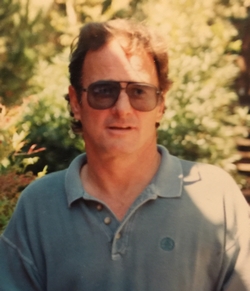
CPT Ralph A. Northrup
Troop B, 2d Squadron, 17th Cavalry, 101st Airborne Division
(Airmobile) |
Captain Ralph A.
Northrup, Class 8-67 Company B2
Citation:
The
President of the United States takes pleasure in presenting the
Distinguished Service Cross to Ralph A. Northrup, Captain (Armor),
U.S. Army, for extraordinary heroism in connection with military
operations involving conflict with an armed hostile force in the
Republic of Vietnam, while serving with Troop B, 2d Squadron, 17th
Cavalry, 101st Airborne Division (Airmobile). Captain Northrup
distinguished himself by exceptionally valorous actions on 11
January 1970 while serving as pilot of a Light Observation
Helicopter operating in support of a Ranger patrol pinned down by
an enemy force in Quang Tri Province. Upon arrival at the embattled
patrol's location, Captain Northrup discovered that there was no
landing zone. Despite heavy enemy fire and inclement weather, which
had hindered previous extraction attempts by larger helicopters,
Captain Northrup chose to cut a swath through the thick jungle
canopy. Using his skids and rotor blades to part and chop several
trees, he was able to hover about two meters above the ground. He
remained in this position for three minutes while a critically
wounded patrol member was strapped to the helicopter's skids. He
then extracted the man from the jungle and flew him to a makeshift
landing zone about two thousand meters away. He repeated this
action three more times under intense enemy fire. Each time he
maneuvered close enough to the ground so that the stranded patrol
members could cling to the skids and be lifted free. As Captain
Northrup extracted the last patrol members could cling to the skids
and be lifted free. As Captain Northrup extracted the last patrol
member, an estimated twenty-five man enemy force swarmed over the
patrol's former position. Captain Northrup's helicopter was so
battered by damage to the rotors and from enemy fire that he was
later forced to make a successful emergency landing. His
extraordinary heroism and devotion to duty and keeping with the
highest traditions of the military service and reflect great credit
upon himself and the United States Army.
|
|
|
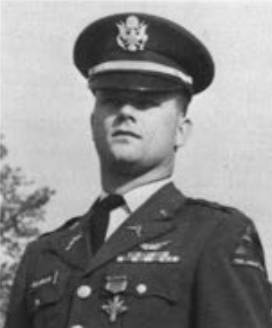
1LT Mark L. Holbrook
Troop A, 7th Squadron, 17th Cavalry, 1st Aviation
Brigade
|
First Lieutenant
Mark
L. Holbrook, Class 12-67 Company F1
Citation: The President of the United States takes pleasure
in presenting the Distinguished Service Cross to Mark L. Holbrook,
First Lieutenant (Armor), U.S. Army, for extraordinary heroism in
connection with military operations involving conflict with an
armed hostile force in the Republic of Vietnam, while serving with
Troop A, 7th Squadron, 17th Cavalry, 1st Aviation Brigade. First
Lieutenant Holbrook distinguished himself by exceptionally valorous
actions on 1 and 2 March 1969 while flying in support of Fire
Support Base Swinger. Despite devastating enemy fire directed at
his aircraft, Captain Holbrook began close-range firing passes over
the enemy positions, destroying their anti-aircraft weapon
emplacement. He then reported the location of each wounded American
soldier to expedite their medical evacuation. After leaving the
contact area to replace his badly damaged airplane, Captain
Holbrook returned to the battlefield to aid a second unit under
hostile attack. Flying into the middle of the enemy fire, he began
to mark positions for air strikes. When he discovered a large enemy
element maneuvering to surround friendly ground troops, he
initiated low passes and halted their forward movement. With the
hostile element pinned down, he flew to another area of contact
where he spotted two enemy vehicles, which he marked as well as
surrounding enemy positions. Despite sustaining numerous hits to
the craft, he ran marking passes which resulted in the destruction
of vehicles, an ammunition depot and much of the enemy force.
Captain Holbrook's extraordinary heroism and devotion to duty were
in keeping with the highest traditions of the military service and
reflect great credit upon himself, his unit, and the United States
Army.
|
|
|
Posthumous
Award
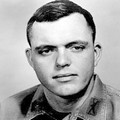
CPT John Dehaas
Curran
227th
Assault
Helicopter Company, 52d Combat Aviation Battalion, 1st Aviation
Brigade
|
Captain John Dehaas
Curran, Class 23-67 Company C1
Citation:
The President of the United
States
of America, authorized by Act of Congress, July 9, 1918 (amended by
act of July 25, 1963), takes pride in presenting the Distinguished
Service Cross (Posthumously) to Captain (Armor) John Dehaas Curran,
United States Army, for extraordinary heroism in connection with
military operations involving conflict with an armed hostile force
in the Republic of Vietnam, while serving with A/227th Assault
Helicopter Company, 52d Combat Aviation Battalion, 1st Aviation
Brigade. Captain Curran distinguished himself by exceptionally
valorous actions on 25 May 1971 while serving as co-pilot on an
emergency medical evacuation mission near Dac To. His helicopter
was embarked on a mission to rescue a seriously wounded survivor of
a U.S. helicopter which had crashed the day before. This involved
braving intense enemy anti-aircraft fire since an estimated two
enemy regiments surrounded the besieged firebase. Captain Curran
realized the enemy situation and strength, but his concern for the
life of a fellow American soldier overshadowed this knowledge. It
was further learned that two ARVN soldiers were also critically
wounded and in dire need of medical evacuation. Captain Curran's
aircraft proceeded through the hail of fire to the firebase and
picked up the seriously wounded American as well as the allied
soldiers. Upon departing the firebase, his helicopter received
heavy enemy fire and lost its motor before it burst into flames and
crashed. Captain Curran's personal bravery and devotion to duty, at
the cost of his life, were in keeping with the highest traditions
of the military service and reflect great credit upon himself, his
unit, and the United States Army. |
|
|
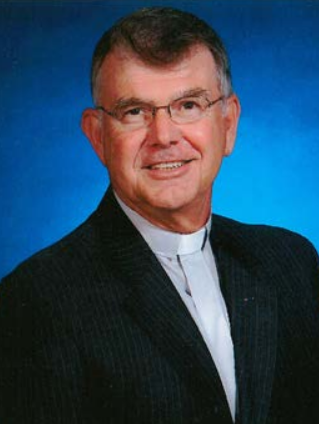
CPT
Carl B.
Marshall
Air
Cavalry
Troop, 11th Armored Cavalry Regiment
|
Captain Carl B.
Marshall, Class 23-67 Company C1
Citation:
The
President of the United States takes pleasure in presenting the
Distinguished Service Cross to Carl B. Marshall, Captain (Armor),
U.S. Army, for extraordinary heroism in connection with military
operations involving conflict with an armed hostile force in the
Republic of Vietnam. Captain Marshall distinguished himself by
extraordinary heroism on 20 January 1970, while serving as an
aircraft commander with Air Cavalry Troop, 11th Armored Cavalry
Regiment, in the Republic of Vietnam. On this date, while flying a
reconnaissance mission near the village of Bu Dop, a light
observation helicopter received intense enemy ground fire, causing
the aircraft to crash and burn in an open field, killing the
co-pilot. The pilot made his way to a nearby bomb crater amidst a
hail of fire from an estimated battalion of North Vietnamese Army
Regulars, who were entrenched in bunkers surrounding the clearing.
Captain Marshall, who was in command of a squad of gunships,
circled the area in an attempt to locate any survivors. Once he
identified the downed pilot, he notified his commander of his
intention to accomplish a rescue. Cautiously lowering the craft
near the crater, Captain Marshall was savagely attacked by a
barrage of small arms and automatic weapons fire from the
insurgents' position. Hovering his helicopter at the proposed site
of recovery, he rotated his gunship, firing his minigun into the
wood line, attempting to suppress the concentrated enemy attack. As
Captain Marshall brought the craft to rest near the bomb crater and
enemy mortar rounds began exploding in close proximity, the gunner
opened the canopy and aided the wounded pilot aboard. With his
helicopter grossly overloaded, Captain Marshall skillfully circled
the open area to gain sufficient speed to clear the tree tops.
After transferring the injured pilot to another helicopter at Bu
Dop, Captain Marshall eagerly refueled, rearmed and returned to the
contact area. Captain Marshall's profound courage, conspicuous
flying ability, concern for his fellow human being, and unwavering
devotion to duty are in keeping with the highest traditions of the
military service and reflect great credit on him, his unit, and the
United States Army.
|
|
|
Posthumous
Award
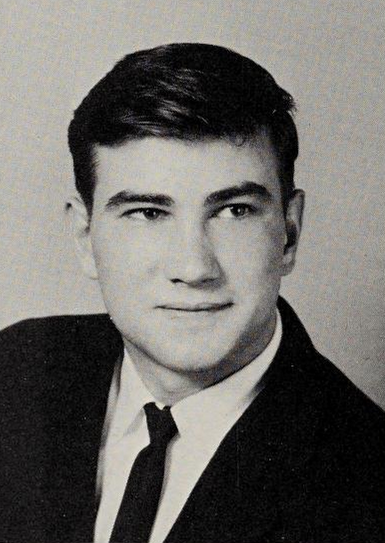
1LT Bernard Lawrence
Pierce
Troop I, 3d Squadron,
11th
Armored Cavalry Regiment |
First Lieutenant
Bernard Lawrence Pierce, Class 30-67 Company D1
Citation:
The
President of the United States takes pride in presenting the
Distinguished Service Cross (Posthumously) to Bernard Lawrence
Pierce (046-34-3275), First Lieutenant (Armor), U.S. Army, for
extraordinary heroism in action in connection with military
operations involving conflict with an armed hostile force in the
Republic of Vietnam, while serving with Troop I, 3d Squadron, 11th
Armored Cavalry Regiment. First Lieutenant Pierce distinguished
himself by exceptionally valorous actions on 19 June 1969 while
serving as leader of an armored platoon near An Loc. Late in the
afternoon his troop and an element of infantry came under intense
hostile rocket grenade and automatic weapons fire. Seeing that the
squad of foot soldiers was pinned down in an exposed position,
Lieutenant Pierce directed his vehicle and another track to go to
their aid. As the two tracks moved in, Lieutenant Pierce's track
was struck by an antitank rocket, the blast of which rendered him
blind. Despite the pain of his serious wounds, he ordered the
assault continued as he valiantly manned his machine gun,
unleashing a fusillade of suppressive fire. Just after the other
track succeeded in rescuing the wounded infantrymen, a
rocket-propelled grenade again struck his vehicle and claimed
Lieutenant Pierce's life. First Lieutenant Pierce's extraordinary
heroism and devotion to duty, at the cost of his life, were in
keeping with the highest traditions of the military service and
reflect great credit upon himself, his unit, and the United States
Army.
|
|
|
|
1LT Phillip L.
Spackman
Troop
E,
1st Cavalry Regiment, Americal Division
|
First Lieutenant
Phillip L. Spackman, Class 1-68 Company E1
Citation:
The
President of the United States takes pleasure in presenting the
Distinguished Service Cross to Philip L. Spackman, First Lieutenant
(Armor), U.S. Army, for extraordinary heroism in connection with
military operations involving conflict with an armed hostile force
in the Republic of Vietnam, while serving with Troop E, 1st Cavalry
Regiment, Americal Division. First Lieutenant Spackman
distinguished himself by exceptionally valorous actions on 2 July
1969 while serving as platoon leader during a unit patrol operation
in the Rice Bowl district near An Lao. As the lead armored
personnel carrier crossed a stream and penetrated a hedgerow, it
was struck simultaneously be several rocket grenades, wounding all
the occupants. A hostile force of North Vietnamese began moving
down the stream bed to cut off the damaged vehicle from the rest of
the troop. Lieutenant Spackman immediately killed the nearest enemy
soldier and repelled the rest of the assailants. While
reinforcements secured the river crossing, he dashed to the vehicle
through strafing automatic weapons fire and removed the casualties
from exposure to direct fire. Then he and the less severely wounded
carried the injured across the stream. Deploying the other vehicles
along the river bank to engage the hostile positions beyond the
hedgerow, he directed their firing as well as that of the gunships
which had arrived. He also established communication with and
assisted the commander of an Infantry element that had been
airlifted near the enemy force. When the infantrymen began
advancing on the communists' flank, Lieutenant Spackman maneuvered
his armored personnel carriers on line and rolled toward the enemy
positions. Encountering stiff resistance from one bunker, he
directed his driver to rush the position. Firing from atop his
tracked vehicle, Lieutenant Spackman pinned the enemy down until
his vehicle passed by the position into which he threw several
grenades, which destroyed the structure and killed the enemy. With
the last bunker eliminated, the enemy were routed from the area.
First Lieutenant Spackman's extraordinary heroism and devotion to
duty were in keeping with the highest traditions of the military
service and reflect great credit upon himself, his unit, and the
United States Army.
|
Keep your contact information current. OCS
graduates update your contact information with Doug Burmester.
|
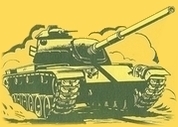
 Home
Home About
Us
About
Us Announcements
Announcements Brigade
Cadre
Brigade
Cadre Class
Narratives
Class
Narratives Class
Rosters
Class
Rosters Class
Statistics
Class
Statistics Class
Web Pages
Class
Web Pages Distinguished
Distinguished Documents
Documents Fiddler's
Green
Fiddler's
Green General
Officers
General
Officers Hall of
Fame
Hall of
Fame Heraldry
Heraldry History
History Medal of
Honor
Medal of
Honor Media
Media OCS
Book
OCS
Book Photos
Photos Reunions
Reunions Roll
of Honor (KIA)
Roll
of Honor (KIA) Virtual
Cemeteries
Virtual
Cemeteries What's
New
What's
New
 Armor
Links
Armor
Links OCS
Links
OCS
Links Veteran
Links
Veteran
Links Doug
Burmester
Doug
Burmester John
Moore
John
Moore Hugh
Preacher
Hugh
Preacher